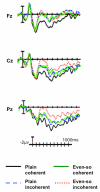Reversing expectations during discourse comprehension
- PMID: 25914891
- PMCID: PMC4405243
- DOI: 10.1080/23273798.2014.995679
Reversing expectations during discourse comprehension
Abstract
In two ERP experiments, we asked whether comprehenders used the concessive connective, even so, to predict upcoming events. Participants read coherent and incoherent scenarios, with and without even so, e.g. "Elizabeth had a history exam on Monday. She took the test and aced/failed it. (Even so), she went home and celebrated wildly.", as they rated coherence (Experiment 1) or simply answered intermittent comprehension questions (Experiment 2). The semantic function of even so was used to reverse real-world knowledge predictions, leading to an attenuated N400 to coherent versus incoherent target words ("celebrated"). Moreover, its pragmatic communicative function enhanced predictive processing, leading to more N400 attenuation to coherent targets in scenarios with than without even so. This benefit however, did not come for free: the detection of failed event predictions triggered a later posterior positivity and/or an anterior negativity effect, and costs of maintaining alternative likelihood relations manifest as a sustained negativity effect on sentence-final words.
Keywords: Discourse processing; ERP; N400; P600; concessive connectives; event structures; late negativity; prediction.
Figures







Similar articles
-
What we know about knowing: Presuppositions generated by factive verbs influence downstream neural processing.Cognition. 2019 Mar;184:96-106. doi: 10.1016/j.cognition.2018.11.012. Epub 2018 Dec 22. Cognition. 2019. PMID: 30584974 Free PMC article.
-
Discourse coherence modulates use of predictive processing during sentence comprehension.Cognition. 2024 Jan;242:105637. doi: 10.1016/j.cognition.2023.105637. Epub 2023 Oct 17. Cognition. 2024. PMID: 37857052
-
From incoherence to mirth: neuro-cognitive processing of garden-path jokes.Front Psychol. 2015 May 12;6:550. doi: 10.3389/fpsyg.2015.00550. eCollection 2015. Front Psychol. 2015. PMID: 26029130 Free PMC article.
-
Prediction during language comprehension: benefits, costs, and ERP components.Int J Psychophysiol. 2012 Feb;83(2):176-90. doi: 10.1016/j.ijpsycho.2011.09.015. Epub 2011 Oct 19. Int J Psychophysiol. 2012. PMID: 22019481 Review.
-
Neural mechanisms of language comprehension: challenges to syntax.Brain Res. 2007 May 18;1146:23-49. doi: 10.1016/j.brainres.2006.12.063. Epub 2006 Dec 23. Brain Res. 2007. PMID: 17400197 Review.
Cited by
-
Salience and Attention in Surprisal-Based Accounts of Language Processing.Front Psychol. 2016 Jun 6;7:844. doi: 10.3389/fpsyg.2016.00844. eCollection 2016. Front Psychol. 2016. PMID: 27375525 Free PMC article. Review.
-
Task-dependent evaluative processing of moral and emotional content during comprehension: An ERP study.Cogn Affect Behav Neurosci. 2018 Apr;18(2):389-409. doi: 10.3758/s13415-018-0577-5. Cogn Affect Behav Neurosci. 2018. PMID: 29512030
-
Dynamic Effects of Self-Relevance and Task on the Neural Processing of Emotional Words in Context.Front Psychol. 2016 Jan 13;6:2003. doi: 10.3389/fpsyg.2015.02003. eCollection 2015. Front Psychol. 2016. PMID: 26793138 Free PMC article.
-
The Frequency of Rapid Pupil Dilations as a Measure of Linguistic Processing Difficulty.PLoS One. 2016 Jan 22;11(1):e0146194. doi: 10.1371/journal.pone.0146194. eCollection 2016. PLoS One. 2016. PMID: 26799065 Free PMC article.
-
What we know about knowing: Presuppositions generated by factive verbs influence downstream neural processing.Cognition. 2019 Mar;184:96-106. doi: 10.1016/j.cognition.2018.11.012. Epub 2018 Dec 22. Cognition. 2019. PMID: 30584974 Free PMC article.
References
-
- Altmann GTM, Steedman M. Interaction with context during human sentence processing. Cognition. 1988;30:191–238. - PubMed
-
- Baggio G, Van Lambalgen M, Hagoort P. Computing and recomputing discourse models: An ERP study. Journal of Memory and Language. 2008;59:36–53.
-
- Becker CA. Semantic context effects in visual word recognition: An analysis of semantic strategies. Memory and Cognition. 1980;8:493–512. - PubMed
-
- Becker CA. What do we really know about semantic context effects during reading? In: Besner D, Waller TG, McKinnon EM, editors. Reading research: Advances in theory and practice. Vol. 5. Academic Press; Toronto: 1985. pp. 125–169.
-
- Blakemore D. Relevance and Linguistic Meaning. Cambridge University Press; Cambridge: 2002.
Grants and funding
LinkOut - more resources
Full Text Sources
Other Literature Sources
